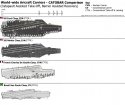This is a decent article from Business Insider, now picked up by Yahoo.Yahoo said:From Business Insider:
Aircraft carriers are the ultimate symbol of a country’s military power and prestige. These floating islands of military power take years to build, and they do not come cheap. The first of the US’s new Ford-class of super carrier has a price tag.
Still, despite the cost, a number of countries have succeeded in building or acquiring a carrier. Although the US has the largest number of carriers with the most advanced technology and the largest flight decks, a variety of carriers of various sizes and sophistication are in use around the world.
The following graphics, created by US Naval Institute member Jeff Head at , breaks down the various carrier classes in use around the world today. The first class, Catapult Assisted Take-Off, Barrier Assisted Recovery (CATOBAR), are the largest and most complex carriers in use today.
The catapult-based launch system the carriers to fly a greater variety of heavy and lightweight planes and at a greater takeoff rate and velocity, compared to non-catapult systems. The majority of CATOBAR carriers are nuclear-powered.
Short Take-Off, Barrier Assisted Recovery (STOBAR) carriers differ from CATOBARs in more than just their launch technology. The carriers are equipped with “ski-jump” ramps that allow for aircraft to take off from the carriers. They are technologically simpler and thus easier to operate than CATOBAR carriers, although aircraft must be lighter to successfully take off from their decks.
STOBARs, like CATOBARs, still use assisted-recovery methods such as trap wires that help aircraft land and decelerate on a dangerously short runway.
Short Take-Off and Landing (STOL) carriers are the to build. Like STOBARs, they run off of conventional rather than nuclear power. Although the carriers sometimes feature a ski-jump to assist with takeoffs, the vessels do not feature any recovery systems to help aircraft land.
Jeremy contacted me and asked if he could use the three graphics I made some years ago regarding the three types. I gave my permission as long as the article was in no way derogatory to the US or the US Navy, and as long as he cited my and my World-wide Aircraft Carrier site. He and his editor agreed.
Although Naval personnel and those tasked with commanding them do not necessarily use the language of CATOBAR, STOBAR, or STOL for carriers, just the same, analysts have developed the terminology and they are helpful to allow Kohn Q. Public to understand the differences, and get a basic feel for the technology involved.
Jeremy did a decent job of that.





